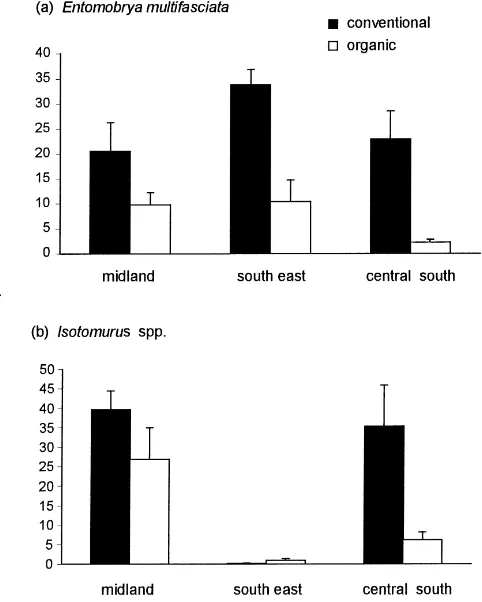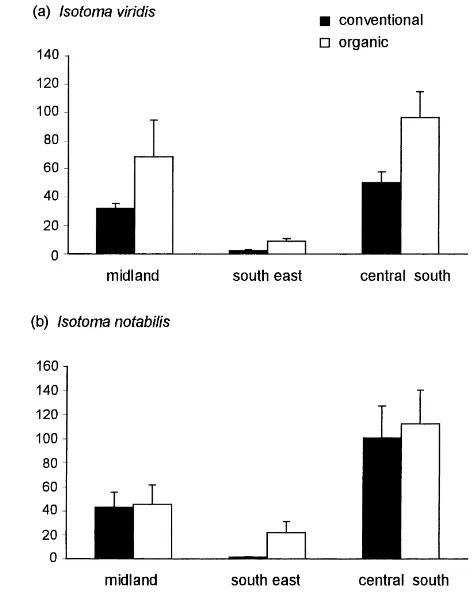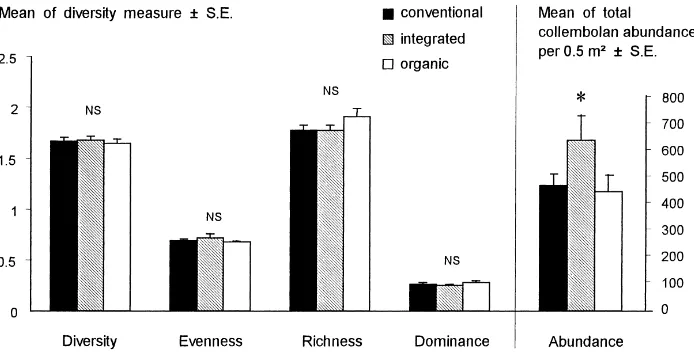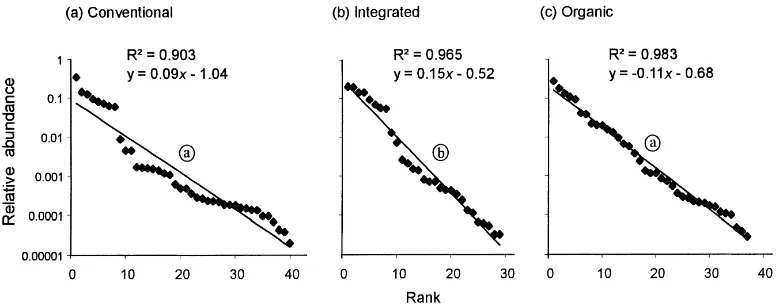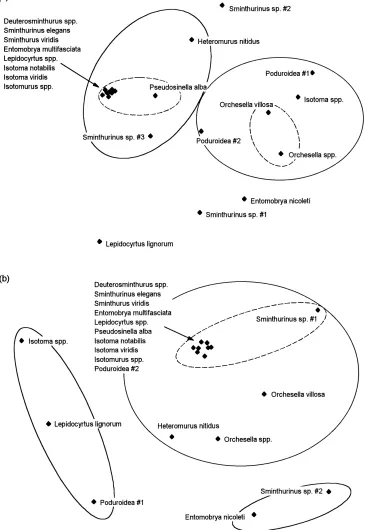Epigeic Collembola in winter wheat under organic, integrated and
conventional farm management regimes
Tania Alvarez
1, Geoff K. Frampton
∗, Dave Goulson
Biodiversity and Ecology Division, School of Biological Sciences, University of Southampton, Bassett Crescent East, Southampton SO16 7PX, UK
Received 17 May 1999; received in revised form 16 May 2000; accepted 21 June 2000
Abstract
Community characteristics of Collembola assemblages in conventional, integrated and organic fields of winter wheat were compared among three randomly chosen areas in England using analysis of similarities, cluster analysis, multi-dimensional scaling and several measures of diversity and evenness. Indicator values were used to identify indicator species. Significant differences were found in the abundance of most species and in community structure among the three geographical regions but few differences between the farming regimes were significant. Despite a lack of significant differences among regimes,
Entomobrya multifasciata and Isotomurus spp. were consistently, although not significantly more common in conventional
than organic fields whereas the opposite was true for Isotoma viridis and Isotoma notabilis. Farming regime significantly affected the abundance of Sminthurinus elegans and Sminthurus viridis but the effect differed between geographical regions. Community composition and species dominance were influenced by farming regime, but no species were indicative of the different farming systems, as most occurred ubiquitously in all fields. Organically and conventionally farmed fields were found not to differ significantly from each other in community composition, but both differed from integrated fields. These findings are compared with the results from other recent European studies of the effects of farming systems on arthropods and their wider ecological implications are discussed. © 2001 Elsevier Science B.V. All rights reserved.
Keywords: Pesticide effects; Farming system; Arable; Arthropods; United Kingdom
1. Introduction
Previous studies investigating the invertebrate fauna of arable fields managed under organic, conventional and integrated farming regimes have reported signifi-cant differences between regimes in faunal diversity. Compared with crops under conventional
manage-∗Corresponding author. Tel.:+44-2380-593112; fax:+44-2380-594269.
1Present address: Zeneca Agrochemicals, Jealott’s Hill Research
Station, Bracknell, Berkshire RG12 6EY, UK.
E-mail address: [email protected] (G.K. Frampton).
ment, organically farmed arable crops had higher diversity and abundance of Carabidae, Staphylin-idae and Araneae (e.g. Kromp, 1989, 1990; Booij and Noorlander, 1992; Steinborn and Meyer, 1994), Collembola (Paoletti et al., 1992) and a range of other beneficial arthropods (El Titi and Ipach, 1989; Moreby et al., 1994; Drinkwater et al., 1995; Redder-sen, 1997). Other low-input farming systems also had a positive effect on Carabidae and Araneae (Steiner et al., 1986; Ulber et al., 1990), Staphylinidae (Krooss and Schaefer, 1998), soil microarthropods (Siepel, 1996) and other soil invertebrates (Steiner et al., 1986; Bardgett and Cook, 1998). Increased biotic diversity
has been associated with greater ecosystem stabil-ity and sustainabilstabil-ity (Seasted, 1984; Bardgett and Cook, 1998). Such potential ecological benefits have been highlighted in support of organic farming for conservation purposes (e.g. Drinkwater et al., 1995).
Results of farming systems studies have, however, not always been consistent. A greater abundance and diversity of carabid beetles was found in conventional than organic fields by Armstrong (1995), perhaps be-cause mechanical weed control disturbed faunal pop-ulations in the organic fields. Brussaard et al. (1990) observed that some species of edaphic Collembola in experimental wheat plots were more abundant un-der conventional management whereas other species were more abundant under integrated crop manage-ment. Foissner (1992) found that climate and farm type were more important than management regime as determinants of species presence and abundance of earthworms, nematodes and Protozoa.
Collembola are among the most abundant of farm-land arthropods, and are important both in arthropod food webs (e.g. Hopkin, 1997) and in decomposition and soil nutrient dynamics (e.g. Petersen and Luxton, 1982; Kiss and Jager, 1987; Mebes and Filser, 1998). Some species of Collembola are vulnerable to the pes-ticides used under conventional farming practices (e.g. Frampton, 1999; Frampton and Wratten, 2000) so a potential exists for pesticide-mediated differences in collembolan abundance between farming systems. No pesticides are permitted in organic farming except for restricted use of copper- or sulphur-based fungicides (Lampkin, 1992). Conventional farming regimes use insecticides, herbicides and fungicides according to need as determined by individual farmers whereas un-der integrated management pesticide use is reduced where possible: generally insecticides are avoided and the main inputs comprise herbicides and fungicides.
Relatively few studies have investigated variation in collembolan abundance between farming systems and none have so far investigated the effects of man-agement practices upon diversity and community composition of epigeic species. Steiner et al. (1986) reported a greater abundance of Collembola in in-tegrated than in conventional fields of cereals and sugar beet, whereas in a study by Brussaard et al. (1990), conventional and integrated management in plots of winter wheat appeared to favour different species of edaphic Collembola, although differences
in abundance were not tested statistically. Paoletti et al. (1992) and Moreby et al. (1994) found a greater abundance of Collembola in organic than conven-tional cereals, but in the latter case only in one of 2 years. Large-scale regional studies in cereals (Red-dersen, 1997) and other arable crops (Dekkers et al., 1994; Czarnecki and Paprocki, 1997) have not de-tected differences between organic and conventional fields in collembolan abundance.
Given the inconsistencies of results obtained from previous work, the present study focused on winter wheat. On one of the study farms where no organic wheat crops were available, a winter triticale crop (wheat×rye hybrid) was sampled instead (Table 1). Management of winter triticale and winter wheat on the farm in question would have been identical in terms of preparatory cultivations, drilling and harvest-ing dates, and pesticide inputs (M.J. Collins, Farm Manager, personal communication). For present pur-poses therefore, the triticale crop is considered in anal-yses as a ‘surrogate’ wheat crop. Using collembolan presence, abundance and community measurements, the aim of the current work was to determine any ef-fects of conventional, organic and integrated farming regimes on epigeic Collembola and whether or not species or community parameters can be identified which are indicative of particular farming systems.
2. Materials and methods
2.1. Study area and experimental design
three areas of England which are here referred to as midland, central south and southeast (Table 1).
2.2. Sampling and species identification
Suction sampling was carried out using a leaf-blower (Ryobi RSV3100) adapted as described in Stewart and Wright (1995). Samples were taken 30 m from the nearest hedgerow and more than 50 m away from any other field edge. Four suction samples were taken at random from each field. For each sample a total area of 0.5 m2 was sampled, comprising five pooled sub-samples each of 10 s duration. All sampling took place between the 9 and 24 June 1997.
Samples were frozen within 3 h of collection. Collembola were later separated by flotation in wa-ter and sieving (3mm mesh) then transferred into 80% methylated spirit. Species were examined us-ing binocular and compound light microscopes and identified with Fjellberg (1980) and Christiansen and Bellinger (1980, 1998).
2.3. Univariate statistical analysis
Collembolan abundance, number of species, and several different indices of diversity were examined. Shannon–Wiener diversity, Pielou’s evenness, Mar-galeff species richness and Simpson’s measure of dominance were obtained using primer computer software (Carr, 1997). Multi-way analysis of variance (ANOVA) was performed on log(x+1)-transformed species counts x, and on untransformed diversity mea-sures to test statistically differences in Collembola parameters among farming regimes and geographical locations. Before analysis each data set was tested for heterogeneity of variances using Cochran’s test (Underwood, 1997) and for departures from normal-ity using the Kolmogorov–Smirnov test (Sokal and Rohlf, 1995). Main effects in the ANOVA model were farming regime (fixed factor), regional area (random factor) and field (random factor) nested within regime and area. A lack of integrated farms in the central south region (Table 1) precluded a fully balanced design so two separate ANOVAs were carried out: (1) organic fields were compared with conventionally managed fields in three areas; (2) all three farming regimes were compared but using farms only in the
midland and southeast regions. A missing conven-tional field replicate from the southeast group was substituted in analyses with the mean count data from the other eight conventional fields; the loss in vari-ance was compensated for by adjusting the degrees of freedom used to test the F-value (Underwood, 1997). Differences among regimes in measures of overall diversity and abundance were compared us-ing a one-way ANOVA. Species compositions among regimes were compared using a linear regression of relative abundance against rank number of species. The regression slopes for each farming regime were compared using t-tests for each pairwise comparison. Because multiple tests were carried out, Bonferroni methods were used to adjust the significance level in the t-tests (Sokal and Rohlf, 1995).
2.4. Multivariate analysis
Multivariate analysis was carried out to investigate the complex community data and was complementary to univariate analysis. These techniques are useful for representing communities in two-dimensional space and testing for differences in community com-position. Hierarchical agglomerative cluster analy-sis, multi-dimensional scaling (MDS) and two-way crossed analysis of similarities (ANOSIM) were car-ried out on log (x+1) transformed field mean counts x in order to group fields containing similar communi-ties. Bray–Curtis coefficients of similarity (Bray and Curtis, 1957) were used to produce similarity ma-trices. Analysis of the species similarity matrix was used to identify species assemblages. Rare species, where they contributed less than 1% to the total abun-dance, were omitted from species similarity analysis. Presence/absence data for all species was also used for community comparisons. Species indicative of the different groupings were identified using species indi-cator values (INDVAL; Dufrêne and Legendre, 1997).
3. Results
3.1. Species abundance
Table 2
Differences in individual species counts between organic and conventional fields sampled in three areas (midland, south east and central south)
Species Regime Area Regime×area Field
Lepidocyrtus spp. F1,2=1.48 NS F2,11=2.22 NS F2,11=0.32 NS F11,51=16.46∗∗∗
<0.001 (three-way nested ANOVA).
Sminthurinus elegans (Fitch), Sminthurus viridis (L.), Isotomurus spp., Isotoma viridis Bourlet, I. notabilis Schäffer, and Entomobrya multifasciata (Tullberg). A substantial amount of variation was found to occur among the three geographical areas investigated, but the most important source of variation was between fields at a local scale. Consistently significant differ-ences were found between fields for all the common species investigated (Tables 2 and 3).
Four different trends in the abundance of lower taxa were evident: (1) E. multifasciata and Isotomurus spp. were consistently although not significantly more common in conventionally than organically managed fields in all three areas (Fig. 1a, b), and E. multifas-ciata was most numerous in integrated fields. (2) I. viridis and I. notabilis were consistently although not significantly more numerous in organic than
conven-Table 3
Differences in individual species abundance between southeast and northeast areas in fields managed under organic, integrated or conventional regimes
Species Regime Area Regime×area Field
Lepidocyrtus spp. F2,2=0.37 NS F1,11=8.49∗∗ F2,11=3.61 NS F11,51=16.79∗∗∗
tional fields (Fig. 2a, b). (3) S. elegans and S. viridis showed a significant interaction between regime and area indicating that differences among regimes were not consistent at all geographical locations (Fig. 3a, b). For both of these species few differences were found in counts between organic and conventional fields in the central south region; however, populations were much higher in conventionally managed fields than organically managed midland fields. (4) Lepidocyrtus spp., I. viridis, Isotomurus spp. and I. notabilis all dif-fered significantly in abundance between the midland and southeast regions (Table 3).
3.2. Community parameters
Fig. 1. Differences in the abundance of (a) E. multifasciata and (b) Isotomurus spp. between fields farmed organically and conventionally in three areas. Mean abundance did not differ significantly between regimes (Tables 2 and 3).
found at a field scale (Tables 4 and 5). Only domi-nance differed significantly among regimes (Table 4), the highest values being found in fields farmed organ-ically (mean=0.28, S.E.=0.01) compared with those farmed conventionally (mean=0.26, S.E.=0.01) or under an integrated regime (mean=0.25, S.E.=0.01). Abundance of the order Symphypleona differed between regimes but inconsistently in different ar-eas. Counts of the order Arthropleona and the total Collembola differed significantly among geographi-cal regions but not between management regimes. No significant differences were found in species richness, diversity and evenness measures because of regime or area (Tables 4 and 5).
When only comparing overall regime effects (i.e. ir-respective of regional differences; one-way ANOVA), total collembolan abundance differed significantly, with the highest abundance occurring under integrated
management. No other measures of diversity differed significantly between farming regimes (Fig. 4).
Fig. 2. Differences in the abundance of (a) I. viridis and (b) I. notabilis between fields farmed organically and conventionally in three areas. Mean abundance did not differ significantly between regimes (Tables 2 and 3).
Table 4
Differences in overall abundance and diversity measures for Collembola counts between organic and conventional regimes sampled in three areas (midland, southeast and central south)
Measure Regime Area Regime×area Field
Total Symphypleona F1,2=0.002 NS F2,11=3.85∗ F2,11=4.06∗ F11,51=14.38∗∗∗
Total Arthropleona F1,2=0.24 NS F2,11=5.72∗ F2,11=0.19 NS F11,51=17.64∗∗∗
Total Collembola F1,2=0.07 NS F2,11=6.93∗ F2,11=0.74 NS F11,51=15.76∗∗∗
Total species number F1,2=0.58 NS F2,11=2.85 NS F2,11=0.38 NS F11,51=8.47∗∗∗
Richness F1,2=2.29 F2,11=0.37 NS F2,11=0.29 NS F11,51=16.93∗∗∗
Diversity F1,2=2.69 NS F2,11=0.58 NS F2,11=0.10 NS F11,51=16.93∗∗∗
Evenness F1,2=11.81 NS F2,11=0.16 NS F2,11=0.09 NS F11,51=7.78∗∗∗
Dominance F1,2=19.7∗ F2,11=0.43 NS F2,11=0.06 NS F11,51=13.43∗∗∗
∗P <0.05. ∗∗∗P
<0.001 (three-way ANOVA).
Table 5
Differences in overall abundance and diversity measures for Collembola counts between midland and southeast areas in fields managed under organic, conventional or integrated regimes
Species Regime Area Regime×area Field
Total Symphypleona F2,2=0.13 NS F1,11=5.24∗ F2,11=5.40∗ F11,51=12.36∗∗∗
Total Arthropleona F2,2=6.82 NS F1,11=8.31∗ F2,11=0.70 NS F11,51=19.55∗∗∗
Total Collembola F2,2=2.97 NS F1,11=16.18∗∗ F2,11=1.17 NS F11,51=13.91∗∗∗
Total species number F2,2=2.69 NS F1,11=11.75∗∗ F2,11=0.42 NS F11,51=4.84∗∗∗
Richness F2,2=12.80 F1,11=0.73 NS F2,11=0.07 NS F11,51=7.67∗∗∗
Diversity F2,2=3.84 NS F1,11=1.17 NS F2,11=0.01 NS F11,51=12.61∗∗∗
Evenness F2,2=0.77 NS F1,11=0.01 NS F2,11=0.54 NS F11,51=1.58 NS
Dominance F2,2=26.16∗ F1,11=0.89 NS F2,11=0.03 NS F11,51=11.51∗∗∗
∗P <0.05. ∗∗P
<0.01. ∗∗∗P
<0.001 (three-way ANOVA).
Table 6
Differences in collembolan communities among three agricultural management regimes and three areas in southern England: results of two-way ANOSIM
Details of comparison Test statistic,
R
Significance level
Total collembolan abundance (log-transformed)
Regimes: organic vs. conventional 0.469 P=0.008 Areas: all three areas 0.588 P=0.001 Regimes: all three regimes 0.593 P=0.0001 Areas: midland vs. southeast 0.753 P=0.001
Presence/absence data for all species
Regimes: organic vs. conventional 0.296 P=0.022 Areas: all three areas 0.374 P=0.011 Regimes: all three regimes 0.451 P=0.0001 Areas: midland vs. southeast 0.630 P=0.001
community was dominated by Lepidocyrtus spp. (28 and 34%, respectively).
Cluster analysis grouped species together which were widespread and abundant. The main group com-prised Lepidocyrtus spp., S. elegans, I. viridis, E. multifasciata, Isotomurus spp., I. notabilis, S. viridis and Deuterosminthurus spp. Rarer species showed no relationship to other species’ patterns of abundance (Fig. 6a and b). MDS analysis of the species compo-sition in the samples from each field grouped fields together which were farmed under the same regime in the same area (Fig. 7a and b). However, species in-dicator values (Dufrêne and Legendre, 1997) showed that no species or groups of species were indicative of
Fig. 5. Rank-abundance plots for species trapped in (a) conventional, (b) integrated and (c) organic fields. Slopes for regimes with different letter codes (encircled) differ significantly (t-test; P<0.05).
the groupings produced by MDS and cluster analysis. All numerous species had their highest INDVAL value when the whole data set was treated as one group, suggesting that these species are ubiquitous in all the arable systems investigated; rare species did not differ in abundance from a random distribution among samples.
4. Discussion
4.1. Farming system effects on species abundance
observed differences in collembolan abundance under the integrated and conventional regimes, as Collem-bola populations are known to be reduced by soil disturbance, in particular deep ploughing and heavy machinery use (Heisler, 1991; Kracht and Schrader, 1997).
For species whose abundance was highest in or-ganic fields, e.g. I. viridis and I. notabilis, pesticide use is a possible explanation because the conven-tional and integrated fields had substantially higher numbers of pesticide applications than organic fields. These species are known to be detrimentally affected by herbicide use (Prasse, 1985). The lack of herbi-cide use in organic crops can lead to increased weed cover which would affect microclimate, e.g. by main-taining a higher humidity at the soil surface (Moreby et al., 1994). Both I. notabilis and I. viridis are sus-ceptible to low humidity (Davies, 1929) and it is notable that these species were most abundant under organic management whereas the more xeric species E. multifasciata was more abundant in conventionally farmed than organic fields. Several species of epigeic Collembola, including I. viridis, have been found to be vulnerable to the fungicides propiconazole and tri-adimenol (Frampton and Wratten, 2000), which were used in the integrated and conventional but not or-ganic fields. Few of the fungicides routinely applied to wheat crops have been tested for side-effects on Collembola and other fungicides used in the study fields might have negatively affected Collembola by reducing their fungal food supply. Although several insecticides were used in conventional and integrated fields, these were primarily pirimicarb and cyper-methrin, which appear not to be harmful to epigeic Collembola in winter wheat (Frampton, 1999).
A consistently although not significantly higher abundance of E. multifasciata and Isotomurus spp. was recorded in conventional fields than in organic fields. The former species is relatively xeric and might be at a competitive advantage where humidity at the soil surface is lower, as could occur in conventionally farmed fields where herbicide use reduces weed cover (Moreby et al., 1994). However, such an explana-tion is unlikely to account for the higher abundance of I. palustris in conventional fields as this species is hygrophilic (e.g. Fjellberg, 1980). Recent work has shown that synthetic pyrethroid insecticides (e.g. cypermethrin), which were used in conventional but
not organic fields, can lead to increased abundance of Collembola, including E. multifasciata. (Framp-ton, 1999). Higher abundance of some collembolan species in conventional fields could reflect a negative effect of insecticide use or other conventional crop management practices on predators of Collembola. This would be consistent with observations that num-bers of predatory arthropods are often higher in organ-ically than conventionally farmed fields (e.g. Kromp, 1989, 1990; Booij and Noorlander, 1992; Steinborn and Meyer, 1994). Long-term monitoring has shown that negative effects on predatory arthropods of syn-thetic pyrethroid insecticides can persist for more than one season (Ewald and Aebischer, 1999), meaning that previous insecticide use in the study fields might have contributed to the observed differences between farming systems in collembolan abundance.
Despite the ubiquitous nature of the common Collembola which were identified, considerable vari-ations were found in species abundance among regions. The differences in abundance among the three regions investigated are likely to reflect varia-tions caused by differences in local climate and soil type. For ecological monitoring of farming system effects, the high regional variation in abundance is problematic. Collembolan species composition has been found to vary at a very small geographical scale, between contiguous fields which had identical cropping histories, soil types and management histo-ries (Frampton, 1999). There is a need to integrate the findings from farming systems studies conducted at different geographical scales, first because it is difficult to determine the wider significance of re-sults obtained from small-scale studies (e.g. Moreby et al., 1994). Second, because in studies conducted at a large spatial scale (e.g. Reddersen, 1997 and the current work), effects of farming regimes may be difficult to detect against background ‘noise’ in arthropod abundance caused by factors which vary considerably among geographical regions, such as soil type, climate, sowing date and regional differences in pesticide use.
4.2. Farming system effects on community composition
regimes. The communities in integrated fields were less equitable and less speciose than those found under either of the other two regimes. This pattern of high abundance for a few species is associated with highly stressed environments (Begon et al., 1990). However, it is not clear why fields farmed under an integrated regime with minimum tillage should be more disturbed than either organic or conventional fields which were ploughed. No support was found for organic fields having a greater diversity than other farming regimes, but the most equitable community structure was found under organic farming, in agreement with Steinborn and Meyer (1994). Community equitability has been linked to ecosystem resilience and hence sustainability (Naeem et al., 1995).
It is possible that the diversity measures used were not ideal for detecting community level effects. Many criticisms have been made of the use of diversity mea-sures (e.g. Cousins, 1991) and multivariate analytical techniques are generally accepted as a better approach for detecting pollutant effects (Cairns et al. (1993) and Cao et al. (1996) give general reviews). In comparisons made among multivariate techniques, MDS in particu-lar was found to provide the clearest spatial separation of community structure, although unlike detrended correspondence analysis it does not indicate species importance (Cao et al., 1996). In this study, the ordina-tion techniques did not show any clear differences in species groups among the regimes, although ANOSIM demonstrated significant differences according to regime. In conjunction with the rank-abundance plots, different patterns were discernible but should be treated with caution as these were produced on the whole data set without taking into account regional differences.
5. Conclusions
Several species of epigeic Collembola occurred ubiquitously in winter wheat crops in different geo-graphical regions but their populations did not vary significantly with organic, integrated or conventional farming regimes. This study agrees with most of the existing literature that these farming regimes are not a major determinant of arable Collembola popula-tions, although it should be noted that none of the conventional wheat crops received
organophospho-rus insecticides, which are particularly harmful to Collembola. Differences between farming regimes in community structure and consistent patterns of abundance among individual species were detected which, though not statistically significant, might in-dicate subtle effects of farming regime masked by background variation in abundance. The possibility that consistently higher abundance of certain species under conventional than organic management is in-dicative of negative effects of synthetic pyrethroid insecticides on predatory arthropods warrants fur-ther investigation, as these are among the most frequently-used insecticides in conventional wheat production.
Acknowledgements
The authors thank all the farmers involved in this study for their patience and co-operation, in particu-lar CWS Agriculture and Rhône–Poulenc for allowing sampling within their experimental farms. They also thank K. Hyder and T. Crowe for statistical advice and J. Stout for help with sample collection. This study was carried out as part of a studentship awarded to T. Alvarez by the UK Ministry of Agriculture, Fisheries and Food.
References
Armstrong, G., 1995. Carabid beetle (Coleoptera, Carabidae) diversity and abundance in organic potatoes and conventionally grown seed potatoes in the north of Scotland. Pedobiologia 39, 231–237.
Bardgett, R.D., Cook, R., 1998. Functional aspects of soil animal diversity in agricultural grasslands. Appl. Soil Ecol. 10, 263– 276.
Begon, M., Harper, J.L., Townsend, C.R., 1990. Ecology: Individuals, Populations and Communities. Blackwell Scientific Publications, Oxford.
Booij, C.J.H., Noorlander, J., 1992. Farming systems and insect predators. Agric. Ecosyst. Environ. 40, 125–135.
Bray, J.R., Curtis, J.T., 1957. An ordination of the upland forest communities of southern Wisconsin. Ecol. Monogr. 27, 325– 349.
Cairns, J., McCormick, P.V., Niederlehner, B.R., 1993. A proposed framework for developing indicators of ecosystem health. Hydrobiologia 263, 1–44.
Cao, Y., Bark, A.W., Williams, W.P., 1996. Measuring the responses of macroinvertebrate communities to water pollution: a comparison of multivariate approaches, biotic and diversity indices. Hydrobiologia 341, 1–19.
Carr, M.R., 1997. PRIMER user manual. Plymouth Marine Laboratory, Plymouth, UK.
Christiansen, K., Bellinger, P., 1980. Collembola of North America north of the Rio Grande (Part 1). Grinnel College, Iowa. Christiansen, K., Bellinger, P., 1998. The Collembola of North
America north of the Rio Grande, 2nd Edition. Grinell College, Iowa.
Cousins, S.H., 1991. Species diversity measurement: choosing the right index. Trends Ecol. Evol. 6, 190–192.
Czarnecki, A., Paprocki, R., 1997. An attempt to characterise complex properties of agroecosystems based on soil fauna, soil properties and farming system in the north of Poland. Biol. Agric. Hortic. 15, 11–23.
Davies, W.M., 1929. The effect of variation in relative humidity on certain species of Collembola. Br. J. Exp. Biol. 6, 79–86. Dekkers, T.B.M., van der Werff, P.A., van Amelsvoort, P.A.M.,
1994. Soil Collembola and Acari related to farming systems and crop rotations in organic farming. Acta Zoologica Fennica 195, 28–31.
Drinkwater, L.E., Letourneau, D.K., Workneh, F., van Bruggen, A.H.C., Shennan, C., 1995. Fundamental differences between conventional and organic tomato agroecosystems in California. Ecol. Appl. 5, 1098–1112.
Dufrêne, M., Legendre, P., 1997. Species assemblages and indicator species: the need for a flexible asymmetrical approach. Ecol. Monogr. 67, 345–366.
El Titi, A., Ipach, U., 1989. Soil fauna in sustainable agriculture: results of an integrated farming system at Lautenbach. F.R.G. Agric. Ecosyst. Environ. 27, 561–572.
Ewald, J.A., Aebischer, N.J., 1999. Pesticide use, avian food resources and bird densities in Sussex. JNCC Report No. 296. Joint Nature Conservation Committee, Peterborough, UK. Fjellberg, A., 1980. Identification keys to Norwegian Collembola.
Norsk Entomologisk Forening, Norway.
Foissner, W., 1992. Comparative studies on the soil life in ecofarmed and conventionally farmed fields and grasslands of Austria. Agric. Ecosyst. Environ. 40, 207–218.
Frampton, G.K., 1999. Spatial variation in non-target effects of the insecticides chlorpyrifos, cypermethrin and pirimicarb on Collembola in winter wheat. Pestic. Sci. 55, 875–886. Frampton, G.K., Wratten, S.D., 2000. Effects of benzimidazole
and triazole fungicide use on epigeic species of Collembola in wheat. Ecotox. Environ. Saf. 46, 64–72.
Heisler, C., 1991. Influence of texture damage by mechanical loads on species diversity of springtails in conventional tillaged arable land (Collembola). Entomol. Gener. 16, 39–52.
Hopkin, S.P., 1997. Biology of the Springtails (Insecta: Collembola). Oxford University Press, Oxford.
Kiss, I., Jager, F., 1987. Investigations on the role of the soil mesofauna with litter-bag method under arable conditions. Bull. Univ. Agric. Sci. Godolla 1, 99–104.
Kracht, M., Schrader, S., 1997. Collembola and Acari in compacted soil of agricultural land under different soil tillage systems. Braunschweiger Naturkundliche Schriften 5, 425–440. Kromp, B., 1989. Carabid beetle communities (Carabidae,
Coleoptera) in biologically and conventionally farmed agroecosystems. Agric. Ecosyst. Environ. 27, 241–251. Kromp, B., 1990. Carabid beetles (Coleoptera, Carabidae) as
bioindicators in biological and conventional farming in Austrian potato fields. Biol. Fertil. Soils 9, 182–187.
Krooss, S., Schaefer, M., 1998. The effect of different farming systems on epigeic arthropods: a five-year study on the rove beetle fauna (Coleoptera: Staphylinidae) of winter wheat. Agric. Ecosyst. Environ. 69, 121–133.
Lampkin, N., 1992. Organic Farming. Farming Press Books, Ipswich, UK.
Locke, M.A., Bryson, C.T., 1997. Herbicide-soil interactions in reduced tillage and plant residue management systems. Weed Sci. 45, 307–320.
Mebes, K.H., Filser, J., 1998. Does the species composition of Collembola affect nitrogen turnover? Appl. Soil Ecol. 9, 241– 247.
Moreby, S.J., Aebischer, N.J., Southway, S.E., Sotherton, N.W., 1994. A comparison of the flora and arthropod fauna of organically grown winter wheat in Southern England. Ann. Appl. Biol. 125, 13–27.
Naeem, S., Thompson, L.J., Lawlers, S.P., Lawton, J.H., Woodfin, R.M., 1995. Empirical evidence that declining species diversity may alter the performance of terrestrial ecosystems. Philos. Trans. R. Soc. London 347, 249–262.
Paoletti, M.G., Favretto, M.R., Bressan, M., Marchiorato, A., Babetto, M., 1992. Biodiversita in pescheti forlivesi. In: Paoletti, M.G., Favretto, M.R., Nasolini, T., Scaravelli, D., Zecchi, G. (Eds.), Biodiversita Negli Agroecosystemi. Wafra Litografica, Cesena, pp. 30–80.
Petersen, H., Luxton, M., 1982. A comparative analysis of soil fauna populations and their role in decomposition processes. Oikos 39, 287–388.
Prasse, I., 1985. Indications of structural changes in the communi-ties of microarthropods in the soil in an agro-ecosystem after applying herbicides. Agric. Ecosyst. Environ. 13, 205–216. Reddersen, J., 1997. The arthropod fauna of organic versus
conventional cereal fields in Denmark. Biol. Agric. Hortic. 15, 61–71.
Seasted, T.R., 1984. The role of microarthropods in decomposition and mineralization processes. Ann. Rev. Entomol. 29, 25–46. Siepel, H., 1996. Biodiversity of soil microarthropods: the filtering
of species. Biodiv. Conserv. 5, 251–260.
Sokal, R.R., Rohlf, F.J., 1995. Biometry. Freeman, New York. Steinborn, H.A., Meyer, H., 1994. Influence of ‘biological’ and
conventional (intensive) farming on the predatory arthropod fauna in agroecosystems of Schleswig-Holstein (Araneida, Coleoptera: Carabidae, Diptera: Dolichopodidae, Empididae, Hybotidae, Microphoridae). Faunistisch-Oekologische Mittei lungen 6, 409–438.
Stewart, A.J.A., Wright, A.F., 1995. A new inexpensive suction apparatus for sampling arthropods in grassland. Ecol. Entomol. 20, 98–102.
Tottman, D.R., 1987. The decimal code for the growth stages of cereals, with illustrations. Ann. Appl. Biol. 110, 441–454. Ulber, B., Stippich, G., Wahmhoff, W., 1990. Possible limitations
and impact of supervised plant protection in arable farming.
III. Effects of different intensities of pesticide use on epigeal arthropod predators in winter wheat, sugar beet and winter rape. Z Pflanzenkr Pflanzenschutz 97, 263–283.

